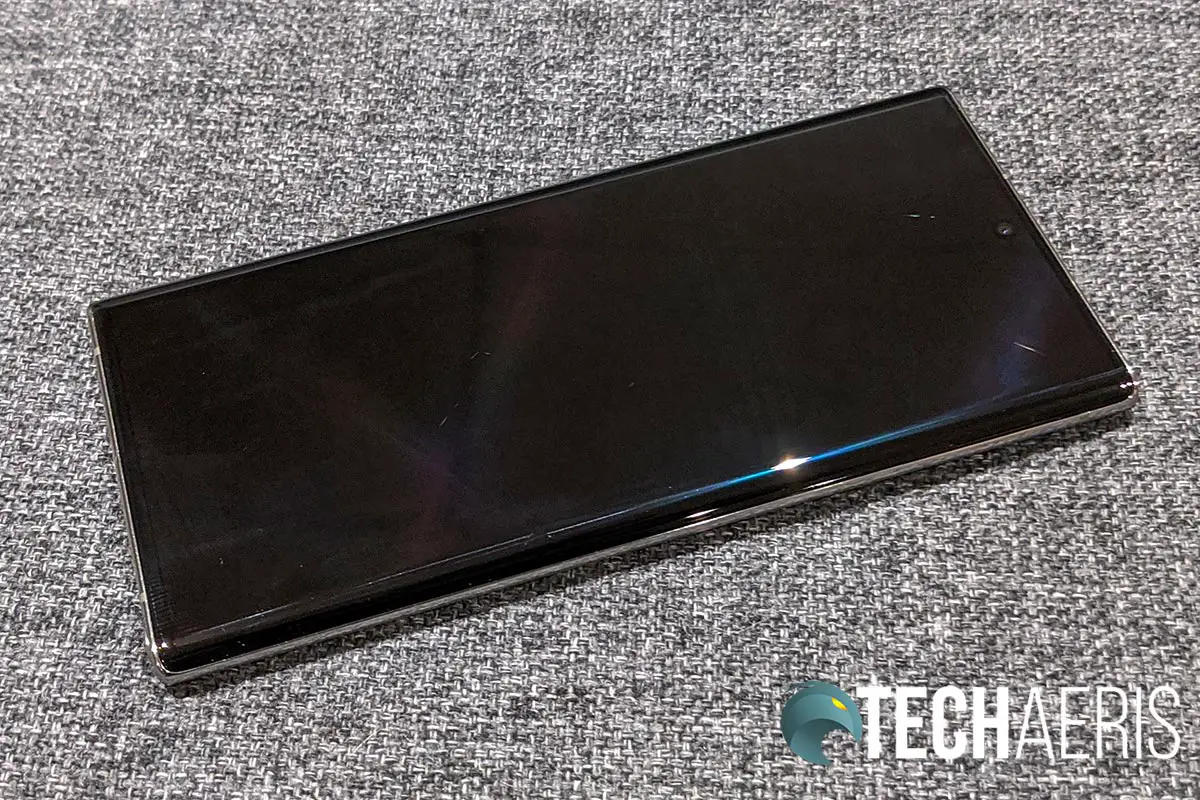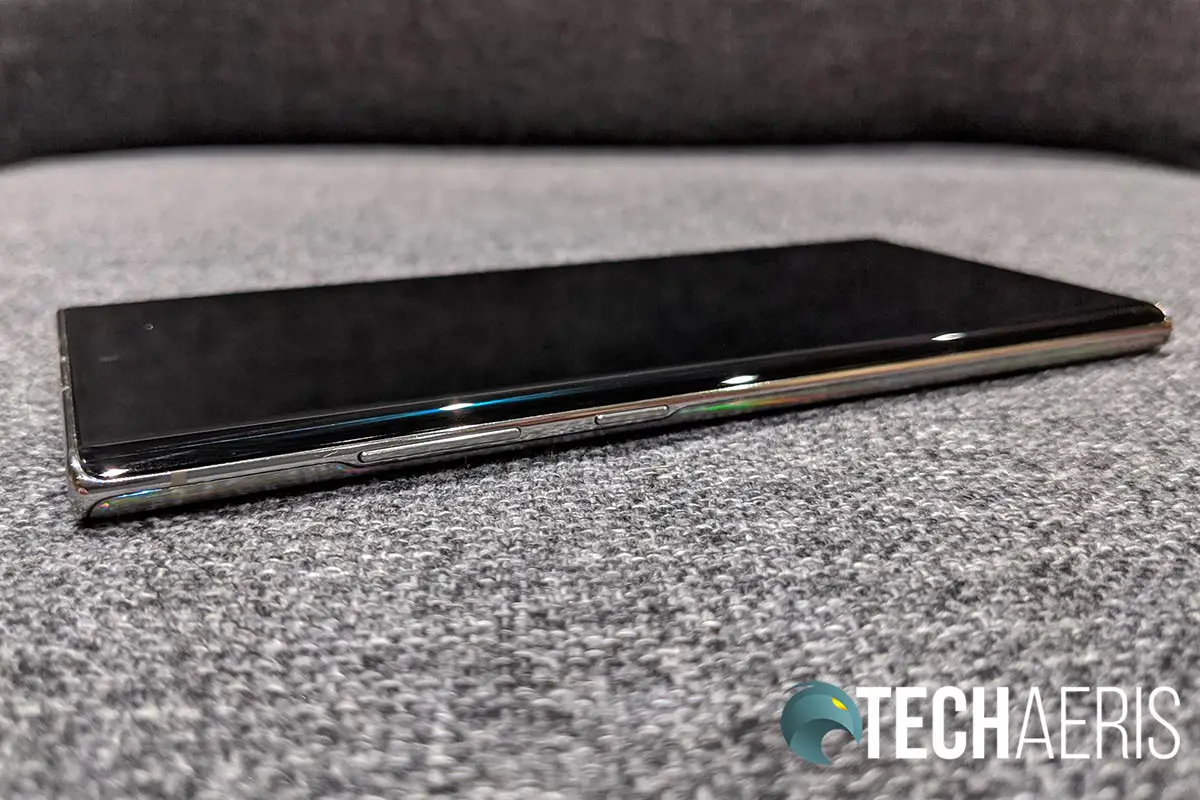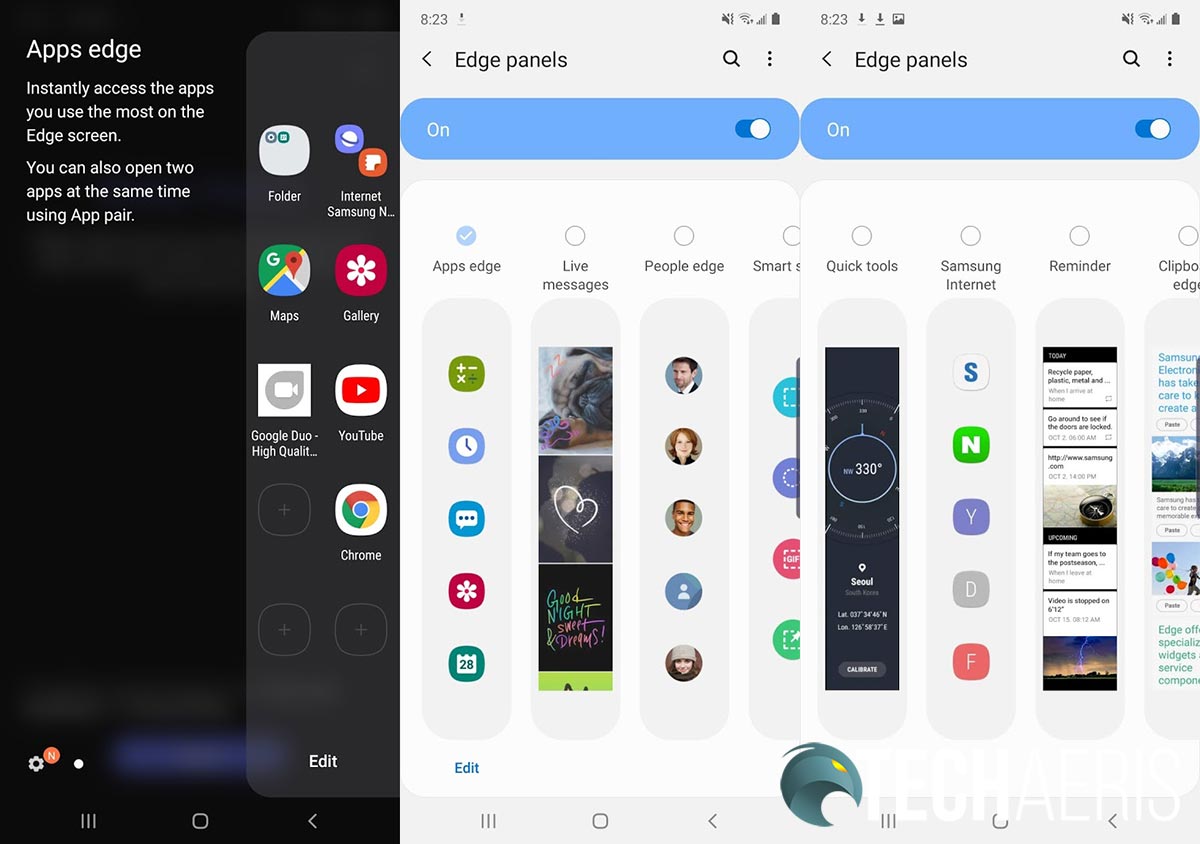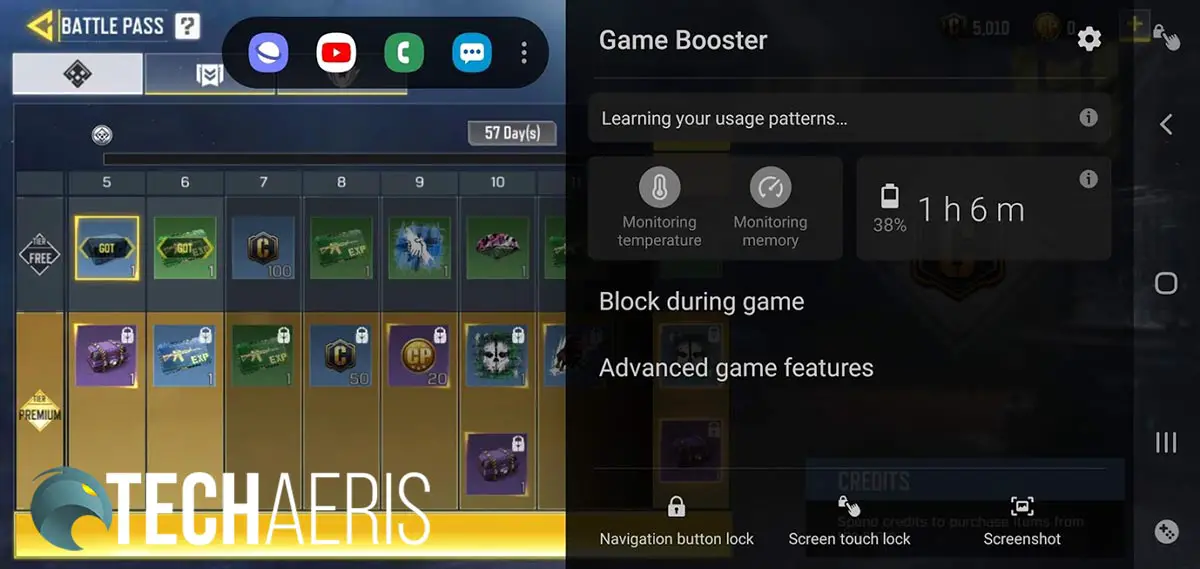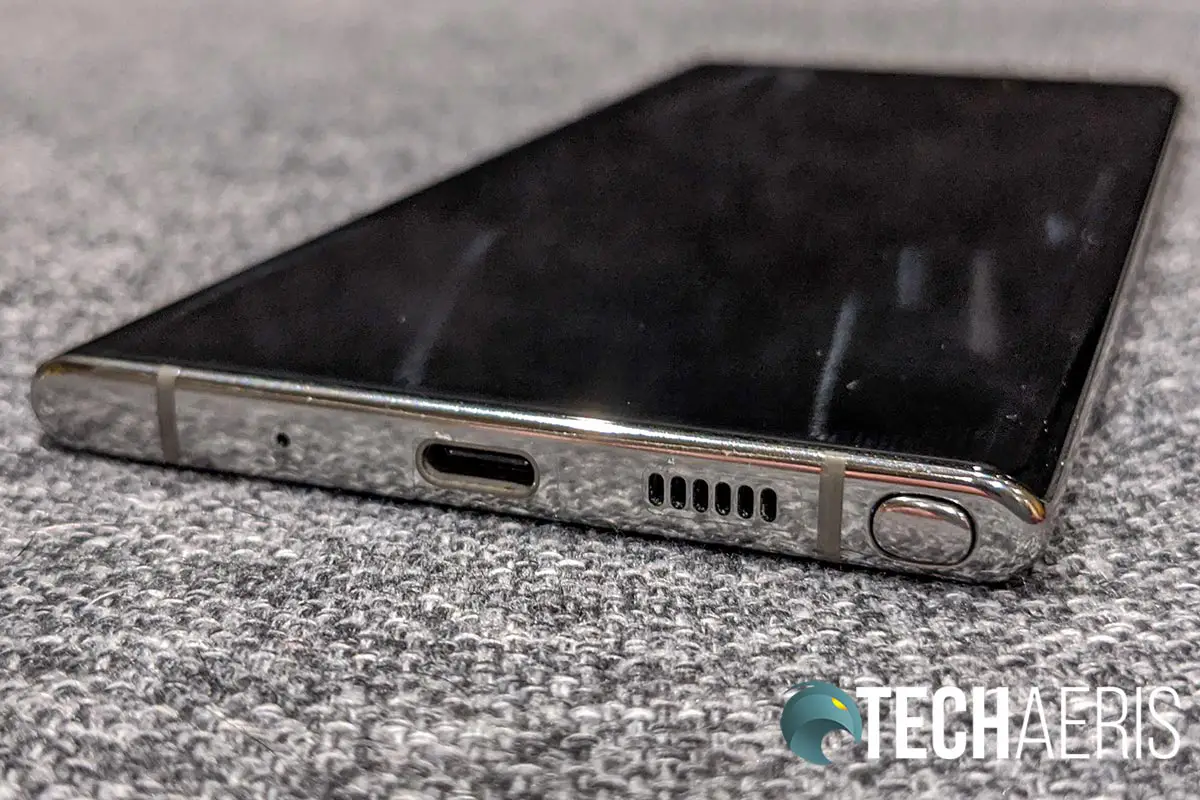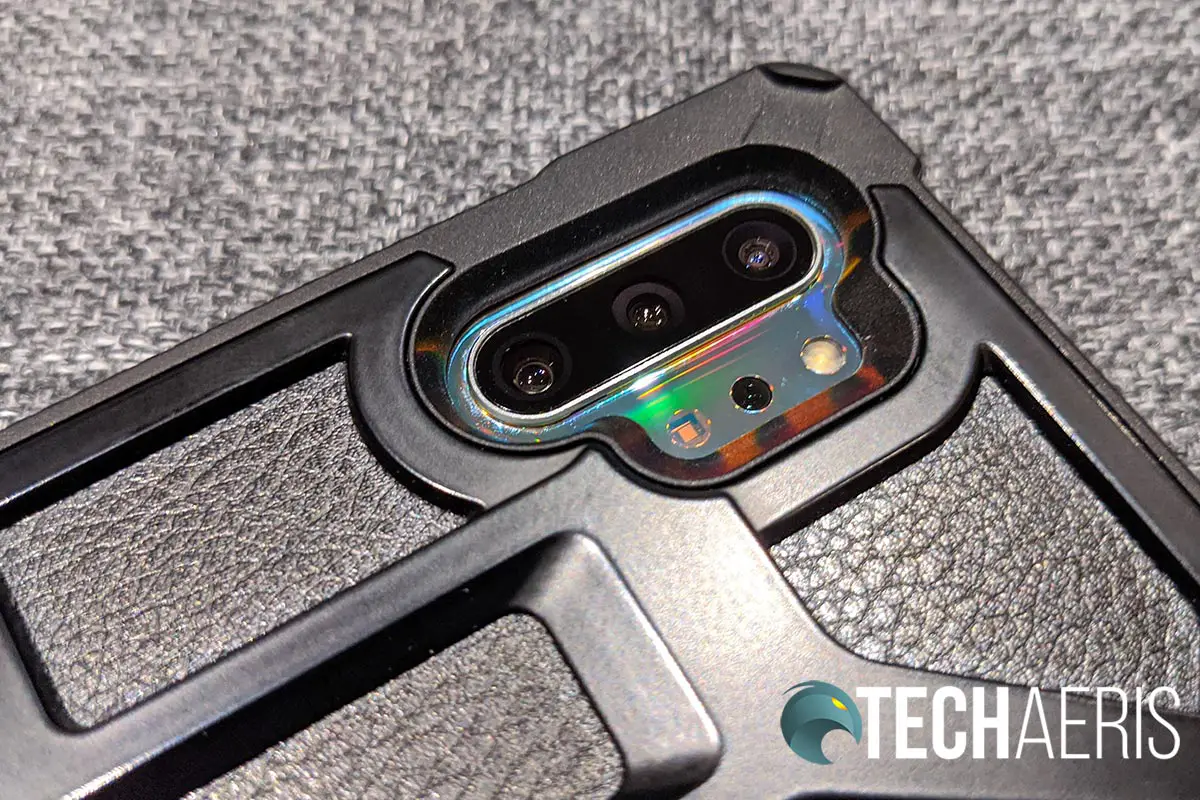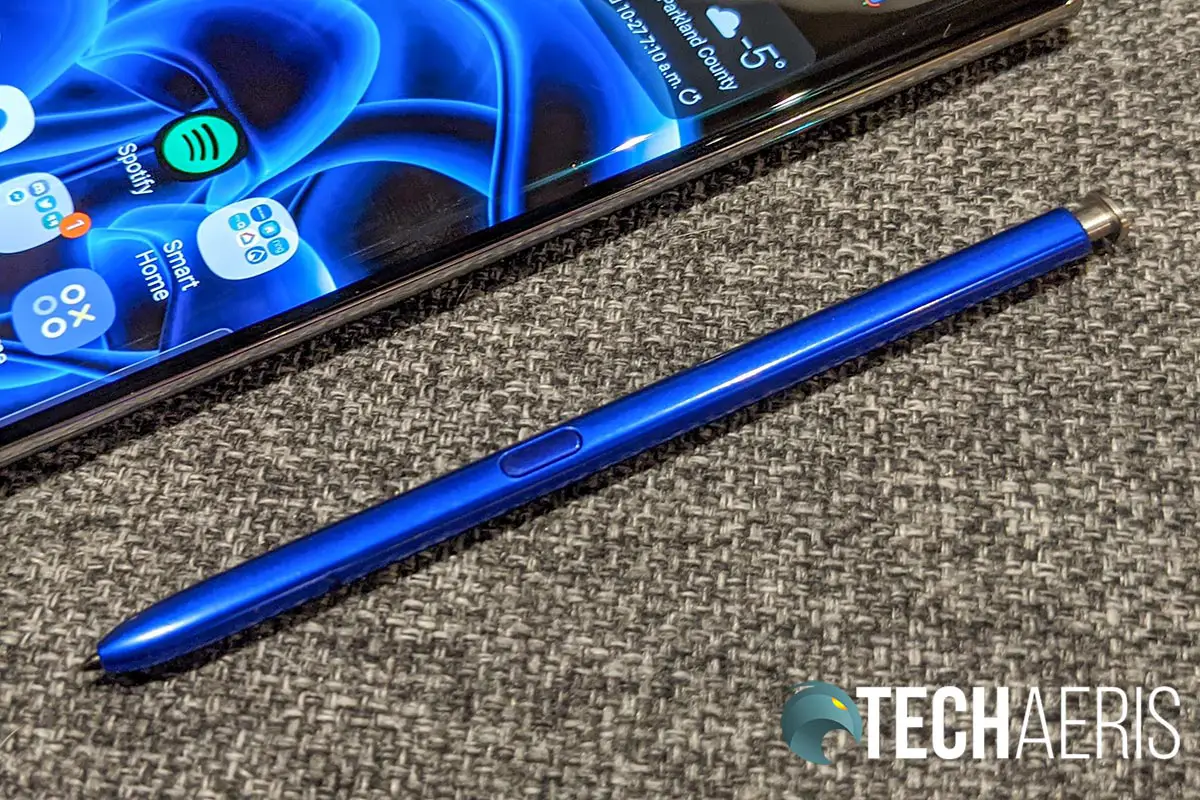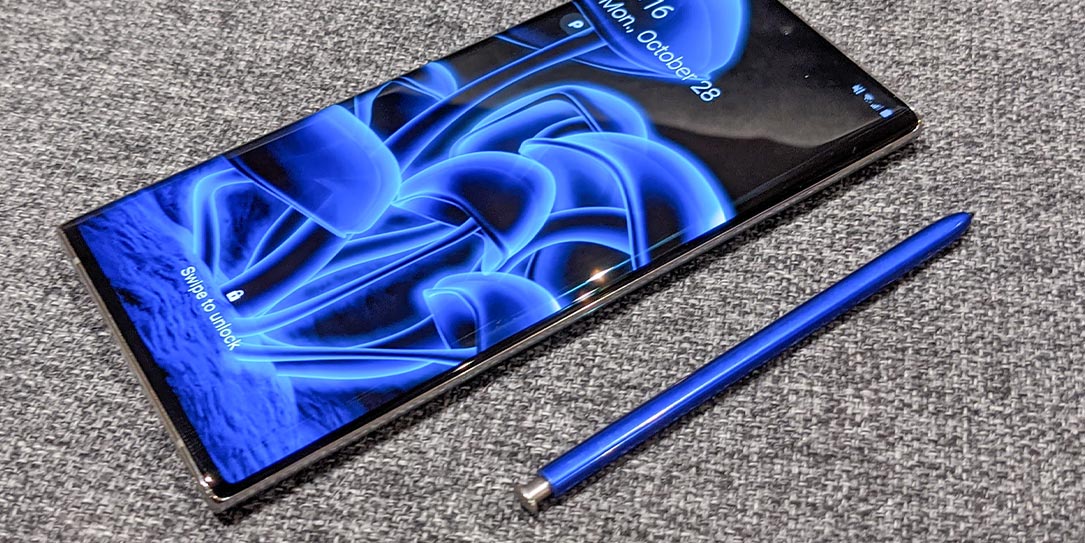
Samsung’s Galaxy Note smartphones have typically been the company’s cream of the crop. This year, the lineup includes two sizes. Our Samsung Galaxy Note10+ review takes a look at the slightly larger version of the flagship devices. Read on for our full review!
Specifications
The Samsung Galaxy Note10+ has the following features and specifications:
- Display: 6.8″ Dynamic AMOLED 3040 x 1440 (Quad HD+)
- Processor: Octa-Core (2.8GHz, 2.4GHz, 1.7GHz)
- Memory: 12GB RAM
- Storage: 256GB (512GB model available, MicroSD support)
- Cameras
- Rear Camera: 12MP + 16MP + 12MP + VGA quad camera, F1.5/F2.4 (Dual Aperture), F2.2, F2.1, F1.4, Auto Focus, OIS, 2x Optical Zoom, 10x Digital Zoom, Flash
- Front Camera: 10MP, F2.2, Auto Focus
- Video: UHD 4K (3840 x 2160) @ 60fps, Slow Motion 960fps (HD), 240fps (FHD)
- Connectivity: USB-C, ANT+, GPS, GLONASS, Galileo, 802.11 a/b/g/n/ac/ax 2.4GHz+5GHz Wi-Fi, Bluetooth v5.0, NFC, PC Sync (Smart Switch)
- Sensors: Accelerometer, Barometer, Fingerprint Sensor, Gyro Sensor, Geomagnetic Sensor, Hall Sensor, RGB Light Sensor, Proximity Sensor
- Fingerprint sensor: In-display, ultrasonic
- Battery: 4300mAh (up to 16 hours internet, up to 21 hours video playback, up to 74 hours audio playback, up to 44 hours talk time)
- S Pen Support: Gesture/Remote Control
- Samsung DeX Support: Yes
- OS: Android 9.0 with One UI 1.5
- Colour: Aura Glow (also available in Aura Black, Aura White, and Aura Blue)
- Dimensions: 162.3 x 77.2 x 7.9mm (6.39 x 3.04 x 0.28″)
- Weight: 196g (6.91oz)
What’s in the box
- Galaxy Note 10+ (duh!) with pre-applied screen protector
- Super-fast 25-watt wall charger
- USB-C to USB-C cable
- AKG earphones (USB-C) + eartips
- S Pen tips and tweezers
- SIM ejector
- USB-A to USB-C adapter
- Micro-USB to USB-C adapter
*NOTE: our review unit shipped without the pre-applied screen protector and no accessories so as a result, we were unable to test any of those out.
Design
The Galaxy Note10+ is a sleek looking phone. With rounded edges, including a curved display, and a very shiny, reflective back in the case of our Aura Glow review unit, it’s definitely flashy. The left side of the device houses the side key and a volume rocker in the upper third of the side. The side key gets a bit of taking used to because it is not the power button by default, as is the case on pretty much every other smartphone out there. The side button can be configured to launch the camera, open Bixby, or open an app. Pressing and holding, which usually turns off your phone, is set to wake Bixby by default. It can be changed to display the power off menu in the settings.
The bottom of the phone is where you’ll find the USB-C port, speaker grille, and S Pen port. The top of the phone is where the SIM card/microSD card slot is located.
The back of the device, as mentioned, is very shiny and reflects the light in different colours with the Aura Glow version. The Samsung logo is printed just above the middle of the phone. The triple camera sits in a camera bump with the fourth camera off to the side, flush with the back alongside the flash.
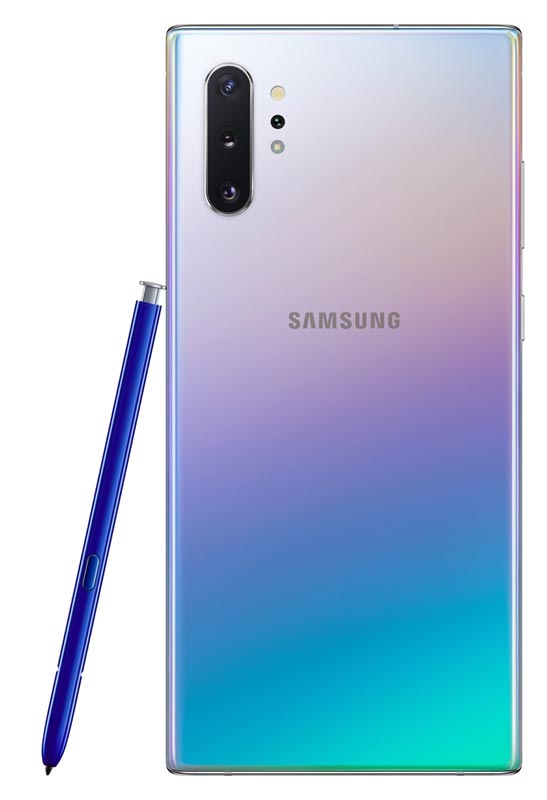
The Galaxy Note10+ itself isn’t overly slippery to hold and the curved edges definitely help with comfort while using it. With any flagship device, however, you’re definitely going to want to grab a case for it to help prevent accidental damage.
Display
The 6.8″ Dynamic AMOLED 3040 x 1440 Quad HD+ is one of the highlights of the device. The screen is crisp, clear, and has pretty decent colour reproduction when set to Natural mode. You can also enable Vivid mode and adjust for warmer or cooler colours if that suits your fancy. Personally, the default natural mode was just fine.
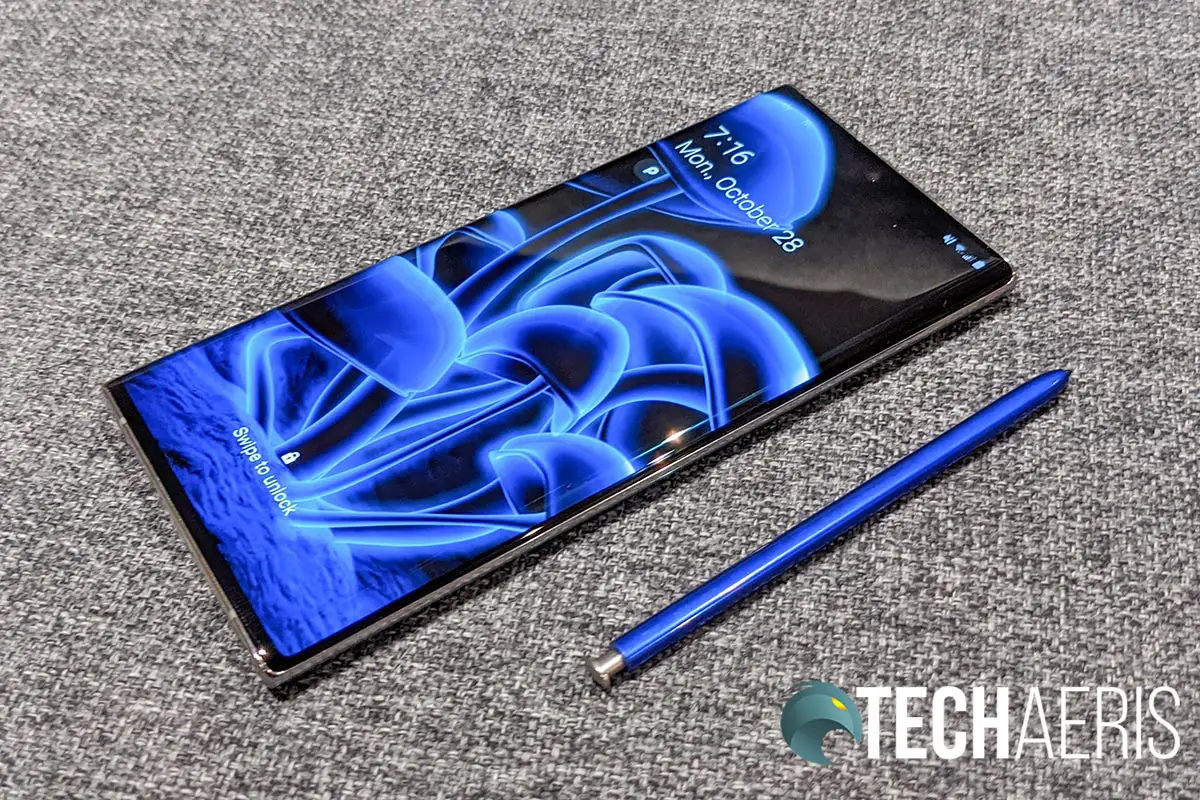
The screen itself goes edge to edge with very small bezels all around. The front-facing camera is centered at the top with the newer pinhole circle design as opposed to a top bezel or notch. While I never had any issues with a top bezel or notch, this newer design definitely offers up a more immersive screen experience, especially while gaming. One thing I did notice though — and it was game dependent — is that the circle can be a minor distraction in the game UI.
Watching video content on the device is a treat as well with the video covering the entire screen for the most part. Again, depending on the content, the circle can be a minor distraction but after a while I stopped noticing it.
One thing to note about the display. By default, at least in the case of our review unit after it was factory reset, the resolution is set to FHD+ (2280×1080) and not WQHD+ (3040×1440). It’s easy to change, of course, but just something you should check if you’re after the higher resolution. Also available is a 1520×720 HD+ option.
At any rate, as I mentioned above, the screen on the Note10+ is fantastic and the edge to edge display really adds an immersive factor to the smartphone experience. After using the device, I’m not surprised it earned an A+ rating from DisplayMate.
Software
The Galaxy Note10+ ships with their One UI 1.5 running on top of Android 9. One UI 2 with Android 10 is currently being tested but hasn’t been released yet. On that note, I’ll admit I’m a huge fan of the stock Android experience on the Pixel devices. I don’t mind some OEM UIs though and after a few days, One UI is pretty straightforward.
As mentioned above, by default, the side key on the device isn’t your power off button. If you opt to keep the default settings for the key, you need to swipe down on your notifications and touch the power icon to access the power off and restart functions of the device.
As far as software is concerned, you can count on the usual Samsung apps being installed, including Gallery, Clock, Contacts, Messages, Samsung Notes, and the like. Try as I did, I eventually had to replace some of these, specifically Messages and the keyboard as I definitely prefer the stock Google versions of those.
That being said, the Note10+ has a lot of useful software features. One of the coolest is the Edge panels and Edge lighting. Edge panels remind me a bit of the BlackBerry KeyONE and KEY2’s Productivity Edge. The Edge panel can be customized and allows easy access to favourite apps, People, messages weather, quick tools, and more. Edge lighting, on the other hand, replaces notification popups and instead causes the edges of the phone to light up when you get a notification.
One of my favourite apps was the Game Launcher. Typically, I place all my games in a folder on my home screen. Game Launcher auto-detects your games and puts them in one easy to access location. The launcher also tracks your play time, offers up YouTube search results, and shows you the average Galaxy gamer play timer for said games. It even has a list of most played games by other Samsung Galaxy owners so you can easily discover new and popular games to play.
The Note10+ also features a Game Booster which monitors your device temperature and memory while you’re gaming. It also allows you to block certain features like notifications and enable advanced game features like Dolby Atmos, auto screen lock, the pop-up panel, and more. For a business-centric phone, the addition of these gaming features is definitely handy.
While the UI was pretty easy to get accustomed to, like any non-Pixel device, updates are a bit slower to come. At the time of this review, the Note10+ still sits on the September 1st Android security patch level. As far as additional security, however, the Note10+ also implements Samsung’s Knox which offers up additional hardware and software-level security.
Speaking of security, the device has both fingerprint and face unlock. While the face unlock feature worked pretty flawless, the in-display fingerprint scanner wouldn’t register sometimes. In addition, there’s currently an issue when using some silicone screen protectors that may allow others to access your device using this method. Samsung is work on and hoping to roll out a fix soon, but in the meantime, you may want to avoid this method if you are using a third-party screen protector.
Samsung’s Bixby is the default voice assistant. During our quick tests with it, it seemed to work decently enough. However, Google Assistant was still my assistant of choice as it is more accurate and tied into my Google Home and other Google apps for better integration. Bixby also has routines. After a few days of using the device, Bixby would ask if I wanted to set up a routine for home, work, or before bed, depending on where I was. An example routine would detect if it’s before bedtime, then you can mute or lower the sound volume, enable the blue light filter, adjust the brightness, enable night mode, and change the lock screen shortcuts (among others). Once set up, the routines do work quite well.
One oddity I did notice is that you can’t actually set up the phone without having a SIM card inserted. While this is usually a non-issue, having multiple phones on the go at most times, I did find it to be odd.
Performance
As far as performance is concerned, the Galaxy Note10+ is a beast with 12GB of RAM, an Octa-core processor, and 256GB of storage space. I definitely had no issues with any apps or games that I ran on the device. App switching is quick, apps and games launch quickly and in games like Call of Duty Mobile on the highest settings had nary a hiccup.
Again, like the resolution settings, the device comes set to the optimized power setting. Other settings include high performance, medium power saving, and battery saver.
Sound Quality
The Note10+ features dual speakers, although you wouldn’t know it at a glance. The bottom speaker is apparent while the second is actually part of the screen. The sound coming from the device definitely gets loud and isn’t distorted at full volume. As is the case with most smartphones, there isn’t a lot of bass either but watching videos and playing games with the onboard speakers was enjoyable enough.
As is the new normal, there isn’t a 3.5mm headphone jack on the device. While the retail units do come with USB-C AKG earbuds, our review unit didn’t so we can’t speak as to the quality of those. I did test out some other USB-C earbuds as well as some Bluetooth headphones and both sounded just fine when using the device.
Camera
With a quad-camera array, the Samsung Galaxy Note10+ should have you covered for most of your photo needs. For the most part, we left the camera on default settings as most users are likely to do. For the Photo mode, Samsung has added quick buttons for normal, 2x zoom, and wide-angle views. This was handy when taking pictures as you could easily zoom in and out to capture the proper frame you wanted.
Other photo modes included are Photo Live Focus, Pro, Panorama, Night, Food, and a new Instagram mode which lets you post to the social media site right from the camera app. Photos came out pretty crisp, as is the case for most flagship smartphones these days. Initially, I had some issues with the focusing feature. When tapping an area to focus, it would take a long time and by then the moment was likely gone. In addition, it didn’t always focus on where I wanted it to. I did test it again recently and it seems much faster and more responsive with accurate focus.
A feature that was huge with my daughter was the AR Emoji function. The camera takes a scan of your face and then generates an AR Emoji of you, and it does a pretty good job. You can then tweak it and generate stickers for use in the Samsung messages app.
On the video side of things, there are Video, Video Live Focus, Super Slow-mo, Slow motion, and Hyperlapse mode. The Note10+ is capable of 4K @ 60fps video recording as well, which is definitely a welcome feature as many other phones cap out at 30fps. We did an unboxing indoors with the camera and had no complaints about the quality.
In addition, you can enable Bixby Vision which uses the camera in conjunction with Foursquare, Pinterest, Google, Vivino, Azumio, Sephora, Ray-Ban, Wayfair, and Gracenote. Enabling this allows the camera to detect places, images, text, wine, food, makeup, products, home decor, and movies to provide the user with specific information. You do have to opt into a lot of third-party apps though to enable this.
Reception/Call Quality
During our time with the unit, I had no issues with reception while on LTE networks in my area, nor call quality. I could hear the other parties just fine and there were no complaints that they couldn’t hear me either.
Battery Life
The Galaxy Note10+ has one of the largest batteries in a smartphone these days. Coming in at a whopping 4300mAh, I had no problems with getting through an entire day of phone use without having to recharge. This was with the device set to WQHD+ resolution and the high-performance setting.
My typical day included about 3 or 4 hours of screen on time, and a mix of web browsing, YouTube, Spotify streaming, and gaming. In fact, there were a few times I managed to get almost 2 days of battery life with about 7 or so hours of screen on time before having to plug in for a recharge.
If you do run low, the device does feature fast charging. While we couldn’t test the charger that comes with it, we were able to get around 50% charge in 30 minutes with some other chargers. The Note10+ is also equipped with wireless charging, which makes charging while you’re at your desk or sleeping even easier.
Accessories
One of the key selling points of the Note10 series is the inclusion of the Intelligent S Pen. While it works great for taking notes and jotting stuff down on the screen, I did find the gestures a bit finicky. Rotating the S Pen is supposed to change the camera angle and it worked about 80% of the time. Volume gestures, moving the tip of the pen up or down, worked about the same amount of the time. The one feature that is pretty much consistent is clicking the button on the S Pen to snap a photo.
While the S Pen is useful in some cases, for the most part it remained in its slot inside the device. Although taking notes with it, which are then transcribed to text, worked well, I still found it faster to open Keep or another app and type or dictate out a memo.
Price/Value
Starting at US$1099.99/CA$1,459.99. the Galaxy Note10+ definitely isn’t cheap. It does feature solid build quality, a great screen, easy all-day battery life, and plenty of other features. Personally, I’d have a hard time dropping this much on a smartphone but if you can justify it, it can definitely be worth it.
Wrap-up
It’s been a while since I personally reviewed a Note device. That being said, as it was now, the Note10+ is still the king of Samsung devices. While it has plenty of features, many are likely to be unused except by the biggest power users. A solid device with a great screen, battery life, and performance, the cost may deter some users from picking up the device.
*We were sent a review unit of the Samsung Galaxy Note10+ for the purposes of this review. In some of our articles and especially in our reviews, you will find Amazon or other affiliate links. Running a website does take money, along with time. Any purchases you make through these links often result in a small amount being earned for the site and/or our writers.
Last Updated on February 3, 2021.

